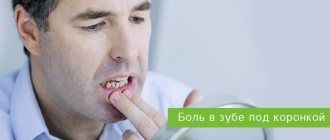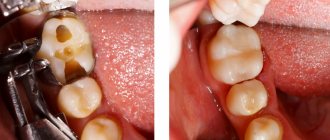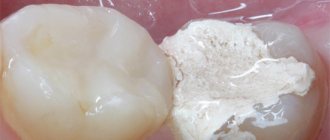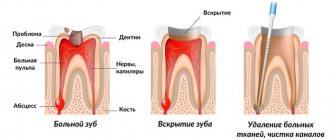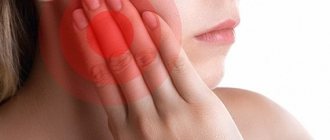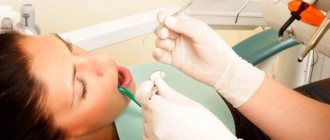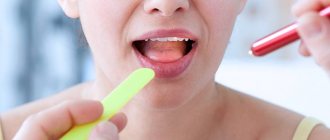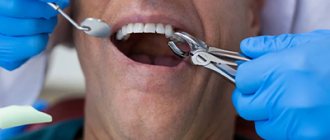Causes What to do about pain?
Home Remedies Dental Care Prevention Having completed treatment, we leave the dentist's office with a feeling of relief. Then the effect of local anesthesia ends and it is discovered that the tooth hurts after the filling. There is no reason to panic and immediately make an appointment. Pain is a natural reaction to medical intervention:
- To prepare a tooth, it is drilled. Nerve endings in hard tissue react to this process by sending pain signals to the brain. The deeper the drill went, the more painful it was.
- When the pulp (nerve) is removed, adjacent vessels and nerve endings are injured.
- The antiseptic used to treat the cavity has a strong irritant effect. It can get into surrounding tissues, causing discomfort.
This kind of pain goes away on its own within up to 2 weeks.
. The main feature: the unpleasant sensations gradually subside and disappear.
What else causes toothache under a filling?
Sometimes, the tooth continues to hurt or causes discomfort. This may be caused by medical error:
- The dentist overdried the dentin, causing a burn. The tooth reacts to temperature stimuli and tapping.
- Dentin was not dried enough. An air gap with negative pressure appears between the filling and the wall, which causes pain.
- When treating deep caries, the doctor damaged the pulp chamber, pathogens penetrated into the pulp and caused inflammation - pulpitis.
- The filling was placed incorrectly; it irritates the gums, causing swelling, redness, and pain.
A broken instrument, too much or too little filling material, allergic reactions to its composition also lead to unpleasant sensations.
The main causes of pain in a filled tooth
A filled tooth hurts quite often. Sometimes slight pain when chewing solid food for 6 to 8 weeks may be normal. The cause of such pain may be:
- minor trauma to the pulp during the treatment of advanced caries, the consequences of which quickly disappear;
- the use of light-curing filling materials for installation of fillings, which have a temporary adverse effect on the pulp.
Significant toothache can be caused by:
- defects in the treatment of pulpitis or periodontitis;
- Violations committed during filling;
- increased sensitivity of the patient's tissues to the filling materials used by the dentist.
Pain associated with incompletely cured pulpitis or periodontitis
Caries is a disease that destroys the hard tissues of the tooth. An infection enters the cavity of a damaged tooth and causes an inflammatory process in the pulp. If the process is not stopped, the infection spreads to the periodontium. This is how the most painful inflammatory processes in the tooth develop - pulpitis and periodontitis. In the absence of adequate treatment for these diseases, the tooth will hurt, especially after filling.
Pain associated with problems with filling
During the filling process, the following mistakes can be made , which can cause pain in the tooth:
- trauma (usually a burn) to the pulp when treating a tooth before installing a filling; this leads to relapse of pulpitis and toothache;
- when installing the filling, the ability of the filling material to settle was not taken into account; this leads to the formation of cracks, infection in the pulp and relapse of the disease;
- too intensive treatment of the tooth with acid, which leads to significant penetration of the filling agents into the tooth, irritation of the pulp and toothache.
Intense toothache, as well as pain that lasts more than two months, indicate that this is not normal and you should seek help from a dentist. In such cases, the filling is removed and the cause of the pain is determined, including with the help of instrumental research methods.
After an accurate diagnosis has been established, the tooth is re-treated and then filled again, starting with the installation of a temporary filling. And only in the complete absence of pain is the temporary filling replaced with a permanent one.
What to do if your tooth hurts after installing a filling?
You should pay attention to the nature of the pain. If it is aching, tolerable, and is not associated with food intake, then the chances are high that everything will work out on its own.
You should worry if:
- The pain is throbbing, increases towards night, the sealed tooth with the nerve hurts - this indicates inflammation of the pulp.
- Unpleasant sensations appear only when biting or pressing on the filling - most likely, the filling technology is broken.
- There is a feeling that the tooth is sticking out, there is discomfort when chewing - the filling is too large.
- The mouth burns, the gums hurt, the mucous membrane turns red and swells - signs of an allergic reaction.
- The pain does not decrease, but may intensify. The gums swell, general malaise appears, and the temperature rises. These symptoms indicate that periodontitis is developing.
If your tooth hurts after filling
04.01.2015 01:47The occurrence of tooth pain is usually explained by caries, infection, and gum inflammation. Having discovered such an unpleasant phenomenon, we rush to see a doctor - a savior from this unpleasant pain. However, it happens that the long-awaited recovery does not occur; on the contrary, the tooth hurts after filling. The first thoughts may be about the unqualifiedness of the attending physician. The real reason why a tooth hurts after filling can only be explained by a dentist.
There are several reasons for this phenomenon, and it is not always the fault of poor treatment. The process of tooth treatment itself consists of several stages, and failure to complete at least one of them can also cause pain in the tooth after filling.
To find out the reasons why a tooth hurts after filling, a precise description by the patient of the nature of the pain (mild sensitivity, pain when pressing a tooth on a tooth, acute pain, aching, throbbing, etc.), the period of its appearance after treatment (immediately after treatment, after a few hours, a day, etc.).
Tooth sensitivity that occurs when pressing and chewing food can be explained by under-drying or over-drying of the tooth cavity during the treatment process. Overdrying, as well as underdrying, leads to irritation of nerve endings, which in the first case can, as a result, die and cause inflammation.
Also, when pressed, the tooth may hurt during the treatment of periodontitis, in this case the pain is understandable. Improper placement of fillings into root canals can also cause pain when pressing and chewing.
If the pain is acute or throbbing, it is explained by the development of acute pulpitis. The reason is the broken technology of treatment and filling. Even the smallest carious particles left in the tooth cavity can lead to the development of pulpitis.
Pain of a periodic nature, which can occur a day or more after filling and then appears and then disappears, is explained by chronic pulpitis, which is also a consequence of inadequate treatment.
In addition to the reasons described above, pain in the tooth after filling is explained by complex treatment, which could not do without trauma to the periodontal tissues.
First aid yourself when a tooth hurts after filling
To relieve pain and improve well-being, you can take a painkiller. You also need to help the tooth - rinse with a soda-salt solution (half a spoonful of soda and salt are mixed in a glass of warm boiled water).
There are also traditional methods of pain relief, for example, applying propolis crushed with fingers around a sore tooth. A warm decoction of celandine herb can also help relieve inflammation, even of a hidden type, such as pulpitis.
If none of the above methods help alleviate the condition and the tooth continues to hurt for several days or more, you should definitely consult a dentist.
If a tooth hurts after canal filling, carried out in accordance with the technology and without violations, this can be explained by the fact that a residual infectious reaction has occurred at the root apex. Rinsing with decoctions of chamomile, celandine, oak bark, sage, etc. will also help to cope with this phenomenon.
Aching pain in the tooth after filling can be relieved with a light massage of the trigeminal nerve.
Edema and swelling as a consequence of tooth filling
If you notice that the gums around the filled tooth are swollen or swollen, you should contact your dentist, as this is due to the development of a purulent process. The accumulation of pus can lead to its penetration through the bloodstream to the brain with all the ensuing serious consequences.
How to help yourself at home
All home remedies that are recommended for use if a tooth aches under a filling reduce the symptoms, but do not eliminate the cause. These measures are temporary and are applied until you see a doctor. The only exception is natural pain after a filling has been placed.
Pharmacy painkillers will help you relax and sleep. Rinsing with salt or soda relieves irritation. Infusions of herbs, calendula, chamomile, and sage have a disinfectant and anti-inflammatory effect.
Modern dentistry has a negative attitude towards such traditional medicine as a hot compress. This can increase inflammation, cause bleeding and a purulent process.
How to eliminate pain
If a tooth under a filling hurts when pressure is applied, it is advisable to immediately consult a dentist. He can give the necessary recommendations or immediately begin to quickly eliminate the problem. In any case, timely contact with a doctor helps prevent possible complications and relapses. To determine the cause of pain and choose the most effective treatment option, you will need a full dental examination. It may include electroodontometry, cold testing and x-ray examination.
If it is temporarily impossible to visit the dentist, it is recommended to resort to painkillers. However, this solution is temporary. To completely eliminate the problem, you will still need to visit a doctor.
As a result of a dental examination, the doctor may recommend several procedures that will relieve pain at home. Firstly, the patient may be advised to regularly rinse the mouth with warm water, which has been infused with herbs, as well as painkillers and antiseptics. Secondly, you may need to regularly rinse your mouth with soda, iodine, salt and agents such as Chlorhexidine or Furacilin. Thirdly, to eliminate toothaches under a filling, applications with infusions of propolis, chamomile and other plants with an anti-inflammatory effect are often used.
Finally, clove, camphor or fir oil can be used to relieve pain. You just have to keep in mind that these products can cause burns. Therefore, they should be used with extreme caution.
Treatment in dentistry
If you experience severe, increasing pain, you should immediately consult a doctor. Also, you should make an appointment if your tooth ache after filling, although about 2 weeks have passed. The dentist will conduct an examination and order an x-ray examination. An examination will determine whether the filling is in the way. If so, the doctor will simply sand the surface.
The picture will show what causes discomfort:
- periodontal inflammation;
- pulpitis;
- tool fragment.
In this case, the tooth will have to be refilled. The old filling is removed and the reason why the filled tooth aches is eliminated. The duration of treatment depends on the severity of the defect. A piece of the tool can be removed in one go. Severe inflammatory processes will require several visits and endodontic intervention when the canals are re-treated.
If, after installing a filling, a tooth hurts as a result of an allergy to the material, it is replaced using a different composition.
In what cases is pain likely to occur after treatment?
Pain syndrome after treatment of caries with modern technologies and treatment methods is a rare phenomenon, and most likely indicates an error during the procedure. If the caries is superficial, tooth preparation is not even required to eliminate it. The carious surface is simply removed from the tooth enamel by laser grinding. The procedure is absolutely non-traumatic, safe and does not cause pain.
For average caries, grinding is also performed, so there should be no rehabilitation period with pain after therapy. The technology is quite simple and errors are rare.
Pain is a normal consequence of treatment only during the treatment of deep caries with pulpitis or periodontitis, in which the infection penetrates into the tooth cavity and affects the pulp - the neurovascular bundle inside the tooth. In this case, grinding is useless; treatment requires preparation of the tooth, removal of the carious cavity, elimination of infection and filling.
In this situation, after the procedure, when the anesthesia wears off, the patient may feel mild or even severe pain. It can last from several hours to several days and, during the normal course of the recovery process, completely disappears on the third to fifth day. At this time, pain is possible when pressing or pressing on the tooth, biting or chewing food.
If after five days from the moment of treatment the pain has not gone away or, on the contrary, has intensified, swelling and swelling of the gums have appeared, you should urgently consult a specialist. In this case, pain is a clear sign of complications.
Memo for patients
- Do not delay visiting your doctor if there are signs of an allergic reaction.
- If the pain increases, swelling, redness, or fever appears, make an emergency appointment
- Do not relieve pain with antibiotics unless prescribed by a doctor.
- Do not use alcohol or garlic applications, as they can burn the mucous membrane.
- Never heat your tooth
- Follow all dentist recommendations
A qualified doctor, a clinic with modern digital equipment and following the recommendations will help you avoid situations where a tooth hurts after installing a filling.
Expert of the article Bolshakova Evgenia Vladimirovna Dentist-hygienist
More than 11 years of experience
Why does a healthy tooth hurt?
A seemingly healthy tooth without any damage or caries can also hurt when biting.
The reasons for this are increased sensitivity of the enamel. Pain occurs both from mechanical stress and when eating hot, hungry or sour foods. The discomfort is short-term and goes away immediately after the irritant is eliminated.
2 ways to get rid of enamel hypersensitivity:
- Do-it-yourself is the home use of gels and pastes based on fluoride, calcium and other useful minerals (ROCS, SPLAT Biocalcium, Colgate Sensitive, Elmex, etc.).
- Turning to the dentist means professional fluoridation of enamel, remineralizing therapy, as well as enamel extension with filling material.

